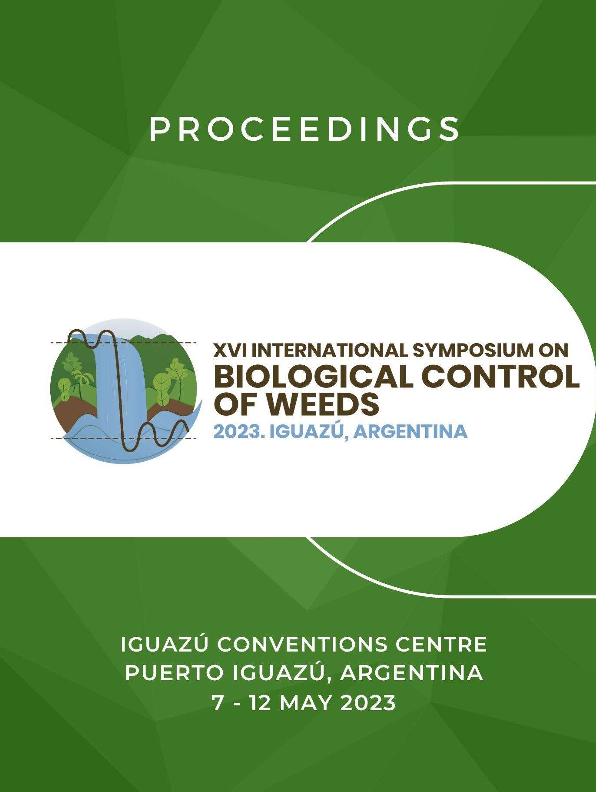Mostrar el registro sencillo del ítem
dc.contributor.author
Angeletti, Bárbara

dc.contributor.author
Daddario, Juan Facundo Fabian

dc.contributor.author
Loydi, Alejandro

dc.contributor.author
Anderson, Freda Elizabeth

dc.date.available
2024-01-08T11:03:36Z
dc.date.issued
2023
dc.identifier.citation
Nassella trichotoma (Poales:Poaceae) crown and root rot diseases in Argentina revisited: preliminary results; XVI International Symposium on Biological Control of Weeds; Iguazú; Argentina; 2023; 48-48
dc.identifier.isbn
978-631-90256-0-6
dc.identifier.uri
http://hdl.handle.net/11336/222689
dc.description.abstract
Nassella trichotoma, a grass species native to South America, has become a noxious weed in many regions of the world. In Australia and New Zealand, it has been targeted for classical biological control. Initial studies to identify potential fungal biocontrol agents started in 1999 in Argentina and ended three years later having discarded a rust and a smut fungus. Work on a crown rot associated with tussock die-back symptoms, and believed to be caused by a corticioid fungus at the time, was less detailed, and abandoned with inconclusive results. Almost 20 years later the problem is being revisited, with research focused on plants with die-back symptoms. New surveys have been conducted and diseased plants collected and studied in the laboratory. Surprisingly, five different corticioid fungi were found associated with the crowns and roots of declining tussocks. Several species of Fusarium, belonging to four different species complexes, were also isolated from crowns and/or roots of declining tussocks, while Bipolaris sp. was isolated from a seed of N. trichotoma recovered from a burial trial within a patch of diseased plants. Artificial inoculations with all the obtained isolates were carried out on healthy N. trichotoma plantlets. After many failed inoculation experiments, it was concluded that the corticioid fungi were not acting as pathogens but rather as secondary colonisers on senescing plant material. In contrast, all the plantlets inoculated with Bipolaris sp. and Fusarium spp. developed some degree of crown and root discoloration and rot, and the inoculated fungi were all re-isolated from affected tissues. Because these pathogens were also found associated with seeds recovered from the soil around diseased plants, healthy seeds were inoculated with Bipolaris sp. and one Fusarium isolate in a separate experiment, causing a great decrease in their germination compared with un-inoculated ones. Surviving seedlings were less vigorous than those grown from healthy seeds. Overall, although all the tested isolates (other than the corticioid ones) were shown to cause some level of disease, none of them produced the die-back symptoms observed in the field. It is now presumed those are caused by more than one of these pathogens acting together in an additive or synergic manner. Moreover, at least two of them have been shown to have an impact on plant recruitment processes. More work is needed to clarify the etiology of this disease in Argentina and to fully assess the suitability of the involved fungi as biocontrol agents.
dc.format
application/pdf
dc.language.iso
eng
dc.publisher
International Symposium on biological control of weeds
dc.rights
info:eu-repo/semantics/openAccess
dc.rights.uri
https://creativecommons.org/licenses/by-nc-sa/2.5/ar/
dc.subject
Nassella trichotoma
dc.subject.classification
Ecología

dc.subject.classification
Ciencias Biológicas

dc.subject.classification
CIENCIAS NATURALES Y EXACTAS

dc.title
Nassella trichotoma (Poales:Poaceae) crown and root rot diseases in Argentina revisited: preliminary results
dc.type
info:eu-repo/semantics/publishedVersion
dc.type
info:eu-repo/semantics/conferenceObject
dc.type
info:ar-repo/semantics/documento de conferencia
dc.date.updated
2023-11-13T15:54:08Z
dc.journal.pagination
48-48
dc.journal.pais
Argentina

dc.journal.ciudad
Iguazú
dc.description.fil
Fil: Angeletti, Bárbara. Consejo Nacional de Investigaciones Científicas y Técnicas. Centro Científico Tecnológico Conicet - Bahía Blanca. Centro de Recursos Naturales Renovables de la Zona Semiárida. Universidad Nacional del Sur. Centro de Recursos Naturales Renovables de la Zona Semiárida; Argentina
dc.description.fil
Fil: Daddario, Juan Facundo Fabian. Consejo Nacional de Investigaciones Científicas y Técnicas. Centro Científico Tecnológico Conicet - Bahía Blanca. Centro de Recursos Naturales Renovables de la Zona Semiárida. Universidad Nacional del Sur. Centro de Recursos Naturales Renovables de la Zona Semiárida; Argentina
dc.description.fil
Fil: Loydi, Alejandro. Consejo Nacional de Investigaciones Científicas y Técnicas. Centro Científico Tecnológico Conicet - Bahía Blanca. Centro de Recursos Naturales Renovables de la Zona Semiárida. Universidad Nacional del Sur. Centro de Recursos Naturales Renovables de la Zona Semiárida; Argentina
dc.description.fil
Fil: Anderson, Freda Elizabeth. Consejo Nacional de Investigaciones Científicas y Técnicas. Centro Científico Tecnológico Conicet - Bahía Blanca. Centro de Recursos Naturales Renovables de la Zona Semiárida. Universidad Nacional del Sur. Centro de Recursos Naturales Renovables de la Zona Semiárida; Argentina
dc.relation.alternativeid
info:eu-repo/semantics/altIdentifier/url/https://www.iobc-global.org/global_sg_Classical_Weed_BC.html
dc.conicet.rol
Autor

dc.conicet.rol
Autor

dc.conicet.rol
Autor

dc.conicet.rol
Autor

dc.coverage
Internacional
dc.type.subtype
Simposio
dc.description.nombreEvento
XVI International Symposium on Biological Control of Weeds
dc.date.evento
2023-05-07
dc.description.ciudadEvento
Iguazú
dc.description.paisEvento
Argentina

dc.type.publicacion
Book
dc.description.institucionOrganizadora
Fundación para el estudio de especies invasivas
dc.description.institucionOrganizadora
Centro de Recursos Naturales Renovables de la Zona Semiárida
dc.source.libro
Proceedings of the XVI International Symposium on biological control of weeds
dc.date.eventoHasta
2023-05-12
dc.type
Simposio
Archivos asociados
